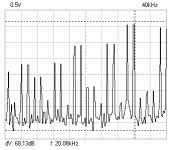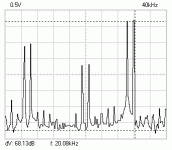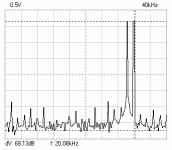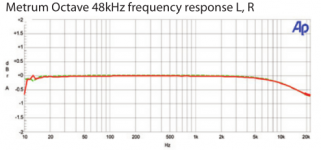Do you think it does even hold a candle to DAC1?
Sonically, yes, the Octave sounds better than the DAC1.
To me, the 5kHz @ 44.1kHz one looks like is a 4 bit sinusoide... Those distortions are not outside the audio band, I bet that using some headphones you could hear the difference.
Don't bet too much money, though. I listened to a 5 kHz sine on my Sennheiser HD600, but no difference with the DAC1. Things get really different, though, in the treble and with the volume turned up quite a bit. Then all sorts of strange sounds depending on the frequency of the sine can be heard. To answer 5th elements, yes there are things happening in the audio band. The reason they're not audible is because they're low level, constantly changing with the music and masked by it.
It's this dynamic behaviour of the hearing threshold that really gets in the way of the interpretation of these measurements. "What you see is what you get" really doesn't work in this case.
I am very interested in a mix of 19+20kHz 1:1 - for both of them.
Here they are, this time limited to the audio band:
Octave; 44.1 kHz; 19 kHz + 20 kHz sinewaves, 1:1;
Octave; 96 kHz; 19 kHz + 20 kHz sinewaves, 1:1;
DAC1; 44.1 kHz; 19 kHz + 20 kHz sinewaves, 1:1.
Attachments
Last edited:
Hi,
This is where trouble starts.
Without having heard the Octave I'd still agree.
The real question is, how do we reconcile this?
The Non-OS Stuff I design does usually measure a little less extreme (in detail, not on THD+N) but it is still far from DAC1 levels or even the new Weiss.
Do we really "like distortion that much", or do the common measurements simply fail to correlate with "good sound"?
Ciao T
Sonically, yes, the Octave sounds better than the DAC1.
This is where trouble starts.
Without having heard the Octave I'd still agree.
The real question is, how do we reconcile this?
The Non-OS Stuff I design does usually measure a little less extreme (in detail, not on THD+N) but it is still far from DAC1 levels or even the new Weiss.
Do we really "like distortion that much", or do the common measurements simply fail to correlate with "good sound"?
Ciao T
Fck iPhone I lost my message. Will try to rewrite later on computer
OK, so what I wrote is pay attention to the first two sinewaves, the second one 1khz at 96k sampling rate is very good. Now imagine the 20khz sinewave if the sampling rate was 352/384khz.
To basically eliminate the need for an aliasing filter, we need DXD resolution, native or oversampled... and a R2R DAC
A good paper:
http://www.digitalaudio.dk/media/dxd_Resolution_v3.5.pdf
Hi,
Do we really "like distortion that much", or do the common measurements simply fail to correlate with "good sound"?
I have >19khz hearing and my ears still prefer a filterless DAC.
I think the answer is this:
As I wrote before: the perfect low pass filter is already in us!
...But something that gets intermodulated from a NOS filterless DAC must still affect the signal in the audible band and creates the "lively" sound mostly associated with NOS dac probably. To move much higher in the frequency spectrum this spuriae is the better solution.
Also, the time distortion of sigma-delta dacs is NOT measured by conventional means.
Thanks! The first two are what I was expecting from my tests, the DAC1 looks like you have only one frequency there...Here they are, this time limited to the audio band:
Octave; 44.1 kHz; 19 kHz + 20 kHz sinewaves, 1:1;
Octave; 96 kHz; 19 kHz + 20 kHz sinewaves, 1:1;
DAC1; 44.1 kHz; 19 kHz + 20 kHz sinewaves, 1:1.
The DAC1 is freakishly good. Seems that they are right about the 110kHz samplerate chosen for up-conversion. And their reason behind the chosen ASRC (AD1896) seems to be right. I won't touch an ASRC that is not DSP generated, but their implementation seems to work.
Hey, now that you like that much the Metrum, don't you wanna sell that garbage of DAC1? I can help you to take care of that poor old DAC
Hey, now that you like that much the Metrum, don't you wanna sell that garbage of DAC1? I can help you to take care of that poor old DAC
Last edited:
I also noticed a few things, but being in the industry and all I think I should avoid comments in public...
One thing that sticks out as a discrepancy is the difference between the freq response as plotted on the AP and as tabulated in the results. The AP response measurement is done at 48kHz - I'm inclined to ask 'why?' as hardly anyone uses that SR these days.
If you look closely at the AP plot - the red line gets thicker above 18kHz and doesn't follow the slope downwards. This almost looks as though it was touched up by hand. But it shows a mere 0.7dB droop at 20kHz which does not accord with either the theory or the tabulated measurements.
Secondly the THD in the table looks uncharacteristically poor, even for a NOS DAC. I wonder if the imaging products got into the measurement? Just estimating by eye from the FFT I'd guess some 10dB lower than what's presented (-60.5dB). The wideband FFT for -10dB stimulus actually shows a test tone around -4dB and harmonics all below -83dB so its surprising that tabulated figure is so poor (-62.3dB).
Attachments
The DAC1 is freakishly good.
No offence, but you havent heard "freakishly good" dacs at all.
...But something that gets intermodulated from a NOS filterless DAC must still affect the signal in the audible band and creates the "lively" sound mostly associated with NOS dac probably. To move much higher in the frequency spectrum this spuriae is the better solution.
I agree to the fact that the audible band is affected by IM, the measurements clearly show that. But I'm not sure if I agree with you on the effect of it on the sound. I've had the Octave less than a day, so it's too early to write comments other than that I've already discovered a few more things about the sound of this DAC than I did during the auditioning last week. Good things that may be unrelated to NOS, though.
If I can get the PDR-555RW working again, I'm going do some of the measurements on that too. It has Legato Link conversion which the marketing blabla says "reconstructs" sound above 20 kHz. What's lost cannot be reconstructed faithfully, but I seem to remember reading somewhere it's just filtering in a way that actually allows a bit of the first image in.
Correct me if I'm wrong on this, please.
Also, the time distortion of sigma-delta dacs is NOT measured by conventional means.
Please elaborate on this.
The DAC1 is freakishly good. Seems that they are right about the 110kHz samplerate chosen for up-conversion. And their reason behind the chosen ASRC (AD1896) seems to be right. I won't touch an ASRC that is not DSP generated, but their implementation seems to work.
I missed this bit, last night. I think you're talking about another device called DAC1. Mine is the French brand Micromega. It's pretty old, the datecodes on the ICs mostly are '94, so I'm guessing it's been made in 1995. DACs are the TDA1305.
Yes I was talking about the DAC1 made by Benchmark. I said that I usually don't like a DAC with ASRC done in off-the-shelf chip. Expression was that ASRC looks better than expected by me in those measurements, now I can see whyI think when SoNic talks 'good' he's referring to measurements, not sound.
I see that TDA1305 is a mixed multibit-DS DAC (5 bit + DS) similar with PCM69 (10 bit + DS). I think that all the DS cips today are done in this technology (they don't advertise anymore how many).
Thanks! I always say that a DAC that measure bad, sounds bad. And almost always I have to explain people that double-negating my affirmation is not logically true (they think that I say "if measures good sounds good").I think when SoNic talks 'good' he's referring to measurements, not sound.
To "measure good" is just a pre-condition that I have experienced is necessary to "sound good".
Last edited:
I agree to the fact that the audible band is affected by IM, the measurements clearly show that. But I'm not sure if I agree with you on the effect of it on the sound. I've had the Octave less than a day, so it's too early to write comments other than that I've already discovered a few more things about the sound of this DAC than I did during the auditioning last week. Good things that may be unrelated to NOS, though.
I specified filterless (like the Metrum) because i have compared on the same R2R NOS dac the application of various filters or no filter at all and prefered the latter, even with the IM.
I was NOT comparing OS vs NOS in my previous post, but i can tell u now: the difference is not big at all, if the oversampling is done "right".
Just remember that sigma-delta dacs cannot work without heavy oversampling and recostruction filter (usually together), and I need not to restate my preference for R2R DACs which at this point should be quite obvous.
Please elaborate on this.
I'm sorry but I dont have with me the documentation i have researched in the past years. I'm going from memory (and moreover I am not a physic or an audio engineer). Some good tech info can be found on the digital audio denmark website (at least from a source that cannot be accused of snake oilism), also at much simpler level there is something on BYOB website, not much on AES papers because well... of marketing reasons they never seriously compared R2R and S-D technologies, as long as the (limited) measurements were comparable.
But there is something about phase distortion in a recent AES paper (like 2010-11). You can find this mentioned (buried) in the blowtorch thread. The author (dont remember name) is a guy to look at since he definitely was into something about new ways of measuring audio equipment that should explain some of the differences we hear that do not appear in the frequency domain.
In short, our ears do not hear the same way as microphones do
And thanks God, i would add.
Sigma-delta DACs mess up completely the original phase (timing) of the signal that the result has maybe only 5% of the bits in the same place. We perceive this recreated sound as "sweet" "airy" pleasant... like when using sucralose instead of brown cane sugar.
The DAD paper i quoted or another one i read long ago give similar accusations to DSD which in the final ratificaton didnt have the 8 bits that Meitner designed it with, for copyright protection ofc. So much the audio industry has screwed music lovers in the last 30 years... I dont wanna think about it.
We can see a little hope just now with expanding native 24/176+ registrations offered to us in the same format without (possibly) dozens manipulations... but this is another topic.
Sorry for the rant.
Hi,
This is a special "feature" of the AP2. It offers two modes of measuring frequency response, if the wrong one is selected the utrasonic images are detected as signal and no or very small roll-off is recorded, even where we expect the normal sinc rolloff.
Well, there does seem to be spray of harmonics at about equal levels, as these add up geometrically this can quickly go high if you do not have one dominant harmonic...
Ciao T
One thing that sticks out as a discrepancy is the difference between the freq response as plotted on the AP and as tabulated in the results. The AP response measurement is done at 48kHz - I'm inclined to ask 'why?' as hardly anyone uses that SR these days.
If you look closely at the AP plot - the red line gets thicker above 18kHz and doesn't follow the slope downwards. This almost looks as though it was touched up by hand. But it shows a mere 0.7dB droop at 20kHz which does not accord with either the theory or the tabulated measurements.
This is a special "feature" of the AP2. It offers two modes of measuring frequency response, if the wrong one is selected the utrasonic images are detected as signal and no or very small roll-off is recorded, even where we expect the normal sinc rolloff.
Secondly the THD in the table looks uncharacteristically poor, even for a NOS DAC. I wonder if the imaging products got into the measurement? Just estimating by eye from the FFT I'd guess some 10dB lower than what's presented (-60.5dB). The wideband FFT for -10dB stimulus actually shows a test tone around -4dB and harmonics all below -83dB so its surprising that tabulated figure is so poor (-62.3dB).
Well, there does seem to be spray of harmonics at about equal levels, as these add up geometrically this can quickly go high if you do not have one dominant harmonic...
Ciao T
You know that for a fact or is just another mith?Sigma-delta DACs mess up completely the original phase (timing) of the signal that the result has maybe only 5% of the bits in the same place.
Adding up all that -80dB crap will get you at -60dB, because it is soo much of it. I really think that -60dB cannot realistically sound good...Secondly the THD in the table looks uncharacteristically poor, even for a NOS DAC. I wonder if the imaging products got into the measurement? Just estimating by eye from the FFT I'd guess some 10dB lower than what's presented (-60.5dB). The wideband FFT for -10dB stimulus actually shows a test tone around -4dB and harmonics all below -83dB so its surprising that tabulated figure is so poor (-62.3dB).
Last edited:
Well, there does seem to be spray of harmonics at about equal levels, as these add up geometrically this can quickly go high if you do not have one dominant harmonic...
When I was regularly using an AP1 I recall there was a 22kHz low pass filter which gave the best out-of-band rejection and hence most optimistic THD+N figure. But I can't recall how steep its roll-off was. My suspicion is the tabulated THD+N figure includes some non-harmonics at 43.1kHz and 45.1kHz. Since these are around -40dB on the FFT if the low-pass provides 20dB rejection by 44kHz (i.e. the filter is 4th order) it could account for this reading.
I really think that -60dB cannot realistically sound good...
So then - what's your working hypothesis to explain why there are soooo many glowing reports on its sound. That all listeners are lying and secretly on Metrum's payroll? Or all are totally deluded or have cloth ears?
- Status
- This old topic is closed. If you want to reopen this topic, contact a moderator using the "Report Post" button.
- Home
- Source & Line
- Digital Line Level
- Metrum Octave Dac - What are the Chips used




